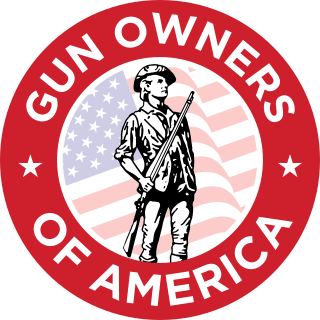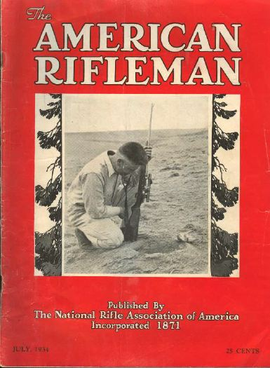Related Research Articles

The National Rifle Association of America (NRA) is a gun rights advocacy group based in the United States. Founded in 1871 to advance rifle marksmanship, the modern NRA has become a prominent gun rights lobbying organization while continuing to teach firearm safety and competency. The organization also publishes several magazines and sponsors competitive marksmanship events. According to the NRA, it had nearly 5 million members as of December 2018, though that figure has not been independently confirmed.

The Gun Control Act of 1968 is a U.S. federal law that regulates the firearms industry and firearms ownership. Due to constitutional limitations, the Act is primarily based on regulating interstate commerce in firearms by generally prohibiting interstate firearms transfers except by manufacturers, dealers and importers licensed under a scheme set up under the Act.

Gun Owners of America (GOA) is a gun rights organization in the United States. It makes efforts to differentiate itself from the larger National Rifle Association (NRA) and has publicly criticized the NRA on multiple occasions for what it considers to be compromising on gun rights.

Wayne Robert LaPierre Jr. is an American gun rights lobbyist who was the CEO and executive vice president of the National Rifle Association of America (NRA), a position he held between 1991 and 2024.

American Rifleman is a United States-based monthly shooting and firearms interest publication, owned by the National Rifle Association of America (NRA). It is the 33rd-most-widely-distributed consumer magazine and the NRA's primary magazine. The magazine has its headquarters in Fairfax, Virginia.
The American Hunters and Shooters Association (AHSA) was a United States-based non-profit 501(c)(4) organization which operated from 2005 to 2010. The group described itself as a national grassroots organization for responsible gun ownership and advocated for increased gun control. The organization's president, Ray Schoenke, said the AHSA was intended to bridge the gap between urban liberals and rural gun owners, but closed down due to a lack of support from the Obama administration.
Marion P. Hammer is an American gun advocate and lobbyist who was the first female president of the National Rifle Association of America (NRA), from 1995 to 1998.
Clifford Neal Knox was a board member and officer of the National Rifle Association, gun magazine writer and editor, gun rights activist, and prolific author of technical firearms articles and articles related to his interpretation of the Second Amendment and views on firearms laws.

Christopher William Cox is an American lobbyist and public relations consultant. From April 2002 to June 2019 he served as executive director of the NRA Institute for Legislative Action (NRA-ILA), the lobbying arm of the National Rifle Association of America (NRA). As executive director Cox encompassed the roles of chief lobbyist and principal political strategist.
Joseph Warren Cassidy is an American politician and lobbyist who was executive vice president of the National Rifle Association from 1986 to 1991 and Mayor of Lynn, Massachusetts from 1970 to 1972.

The Giffords Law Center to Prevent Gun Violence, previously known as the Legal Community Against Violence and the Law Center to Prevent Gun Violence, is a national public interest law center and nonprofit organization that promotes gun control legislation in the United States and conducted litigation against the gun industry. The Giffords Law Center publishes information about gun laws and gun control. The organization offers legal assistance to public officials, and publishes research on gun laws and gun violence. The organization is currently led by former US Congresswoman Gabby Giffords.
Giffords is an American advocacy and research organization focused on promoting gun control. The organization draws its name from one of its co-founders, Gabby Giffords, a former Democratic member of the U.S. House of Representatives. Rep. Giffords was shot along with 18 others at a constituent meeting in Tucson in 2011. The organization has three parts: a 501(c)(4) lobbying arm, a 501(c)(3) research arm, and a super PAC. It was previously known in a different configuration as Americans for Responsible Solutions.

The Duke Energy Convention Center is a convention center located in downtown Cincinnati, Ohio, United States, covering two city blocks bounded by Elm Street, 5th Street, 6th Street, and Central Avenue.
Franklin Lewis Orth was an American attorney who served as Executive Vice President of the National Rifle Association of America (NRA) from 1959 until his death. In the 1960s, Orth was influential during debates on gun control in the United States. Orth also served as President of the United States Olympic Committee from April 1969 until his death.

Harlon Bronson Carter was an American advocate for gun rights and a leader of the National Rifle Association of America. Carter's 1977 election as NRA Executive Vice President marked a turning point for the organization. During his tenure, from 1977 to 1985, he shifted the organization's focus from promoting marksmanship and sports shooting towards strident advocacy for less restrictive gun laws. Under Carter's leadership, the NRA became less compromising on gun rights issues. It also tripled its membership and gained considerable political influence.

The Trace is an American non-profit journalism outlet devoted to gun-related news in the United States. It was established in 2015 with seed money from the largest gun control advocacy group Everytown for Gun Safety, which was founded by former New York City mayor Michael Bloomberg, and went live on 19 June of that year. The site's editor in chief is Tali Woodward, and it shares its president, John Feinblatt, with Everytown for Gun Safety.
Maxwell Evans Rich was a major general in the United States Army. He also served as an Adjutant General of the Utah National Guard. He was an Executive Vice President of the National Rifle Association of America (NRA).
The Political Victory Fund (NRA-PVF) is the political action committee (PAC) of the National Rifle Association of America (NRA). Founded in 1976, the Fund endorses political candidates on behalf of the NRA and contributes money to those candidate's campaigns. It maintains a rating system which awards grades to political candidates based on their support or opposition of gun control measures.
In February 2018, a boycott emerged against the U.S. gun rights advocacy group National Rifle Association of America (NRA) and its business affiliates. The boycott and social media activism campaign arose in the aftermath of the Stoneman Douglas High School shooting in Parkland, Florida. The NRA was criticized for its response, including its recommendation for schools to arm teachers and opposition to bans on certain weapons. Calls for companies to sever their ties to the NRA resulted in several companies discontinuing their business relationships with the NRA and cancelling discount programs offered to NRA members. The boycott extended to Canada where Mountain Equipment Co-op and the Running Room cut supplier relationships with Vista Outdoor. Public pressure also caused a number of gun retailers to increase the age required to buy firearms and place other restrictions on gun sales.
References
- 1 2 Achenbach, Joel; Higham, Scott; Horwitz, Sari. "How NRA's true believers converted a marksmanship group into a mighty gun lobby". Washington Post. Archived from the original on January 13, 2013.
- 1 2 Davidson, Osha Gray (1998). Under Fire: the NRA and the Battle for Gun Control. University of Iowa Press. pp. 28–36. ISBN 0877456461.
- ↑ Giffords, Gabrielle; Kelly, Mark (2014). Enough: Our Fight to Keep America Safe from Gun Violence. Simon and Schuster. ISBN 9781476750118.
- ↑ Troy, Gil (8 October 2017). "The Teen Killer Who Radicalized the NRA". Daily Beast. Archived from the original on October 8, 2017.
- 1 2 3 4 Kohn, Howard (14 May 1981). "Inside the Gun Lobby". Rolling Stone. Rolling Stone. Archived from the original on July 4, 2018. Retrieved 30 April 2020.
- 1 2 3 4 5 6 Sugarmann, Josh (2010). National Rifle Association: Money, Firepower & Fear. National Press Books. ISBN 978-1451500226.
- 1 2 Gebhard-Koenigstein, August (March 2019). "Rifles and Reinforcement: The National Rifle Association's Partisan Approach to Gun Ownership". CUREJ: College Undergraduate Research Electronic Journal. Archived from the original on September 15, 2023.
- 1 2 3 4 Elena Saavedra Buckley (November 17, 2021). "Sons of Guns". medium.com. Epic (magazine). Archived from the original on November 17, 2021. Retrieved 15 September 2023.
- 1 2 3 Stuart, Reginald (May 23, 1977). "Rifle Group Ousts Most Leaders In Move to Bolster Stand on Guns". New York Times. Archived from the original on August 16, 2019.
- 1 2 Sunstein, Cass; Siegel, Reva; Amar, Akhil; Guinier, Lani (2008). "The Supreme Court 2007 Term". Harvard Law Review. 122 (1): 207–212. JSTOR 40042818.